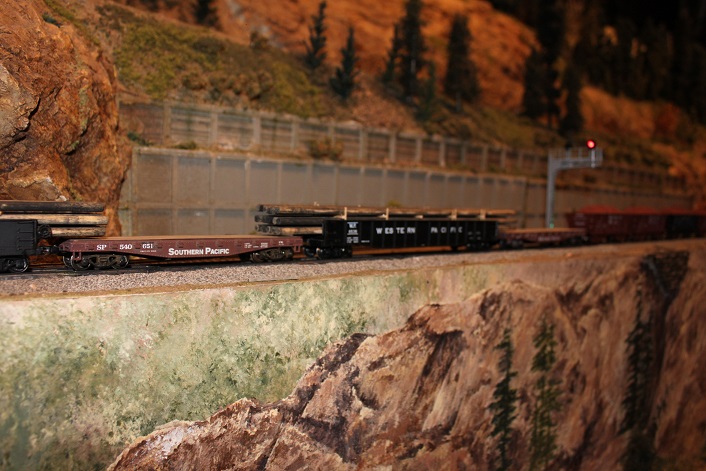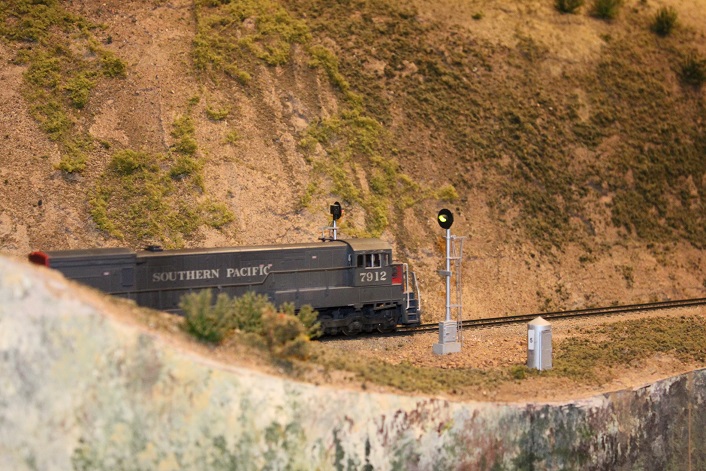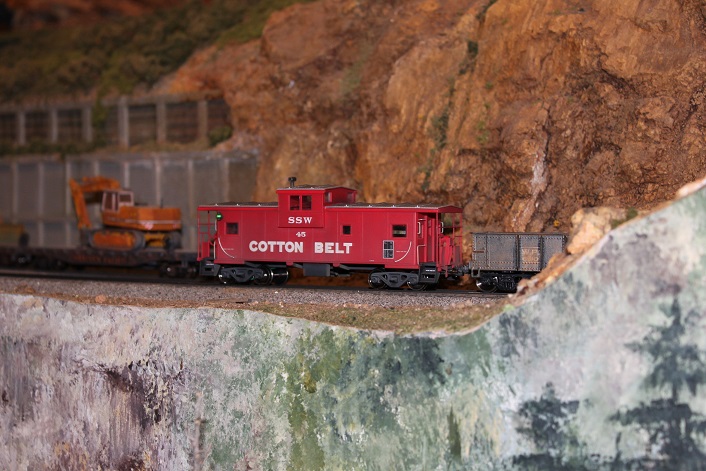Iron Horseman
Well-Known Member
The Quartz Mountain Squeeze (this was edited to remove a lot of railroad jargon for facebook but...)
There was heavy traffic on the road and my tour #251, the venerable ore train, pulled onto the main line in Fairport one block behind Extra 501. The extra soon pulled ahead and there was nothing but green lights going out of Lakeview. Through Dog Lake the whole crew got a treat of a good view of the lake creature which was out in full view right behind the boat house. The train had throttled up to 22 mph as it went up the valley past the hot box detector. Slid right through tunnel #4 and the town of Sycan slick as can be.
Things got interesting when we saw a flashing yellow signal approaching Bly. That isn't so surprising as normally this would mean there is a train waiting for us to pass. However, as we got to Bly the next signal was not the normal yellow, nor was there a train waiting. Instead the signal was flashing red. This means we are pulling into the siding behind a train already there. Bly is a big loop that doubles the railroad back on itself, so one can see the trains further up grade. So we have this flashing red but there are no trains anywhere in sight. That can only mean one thing. A really long wait.
We stopped at the flashing red and then proceeded at less than 5 mph into the siding watching for the caboose of what we assumed would be Extra 501 immediately ahead. Bly is a very long siding so it was no problem fitting the 80 cars of ore in behind 501. And sure enough the wait began. After about an hour, the facing train arrived. But in a way, it was worth it, as the facing train was a re-routed California Zephyr pulled by 4 rare D&RGW F units. That train is a long way from home rails.
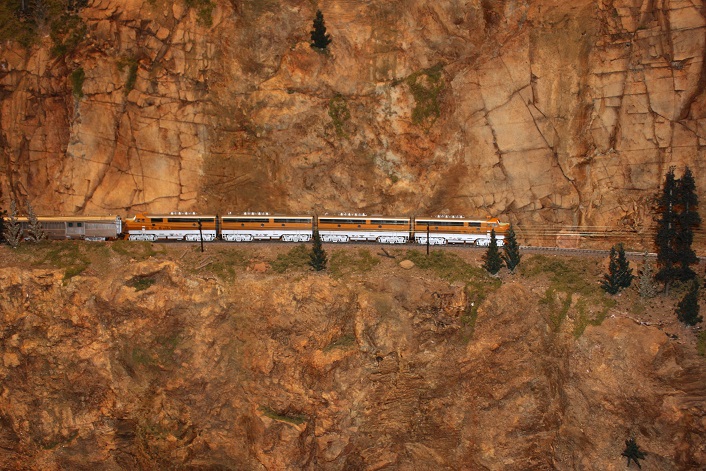
Unfortunately after the Zephyr passed #501 did not leave. Looking across the valley again the reason was clear there was a train running one block behind the Zephyrs glowing drum head. It was not too long a wait before we saw it was the regional train #282, which rolled right on by us.
Finally the caboose of #501 pulled away from our nose as it took the main and we got to move up to the signal at the west end of Bly. We thought we would get to run the yellows and follow 501 up the hill, but it was not to be. It was another fairly long wait before train #232 lumbered by. Finally getting a green, the locos groaned to get the 80 loads of ore moving up hill once again. A herd of antelope looked on to see what all the locomotive grumbling was about as we rounded the turn toward tunnel #6.
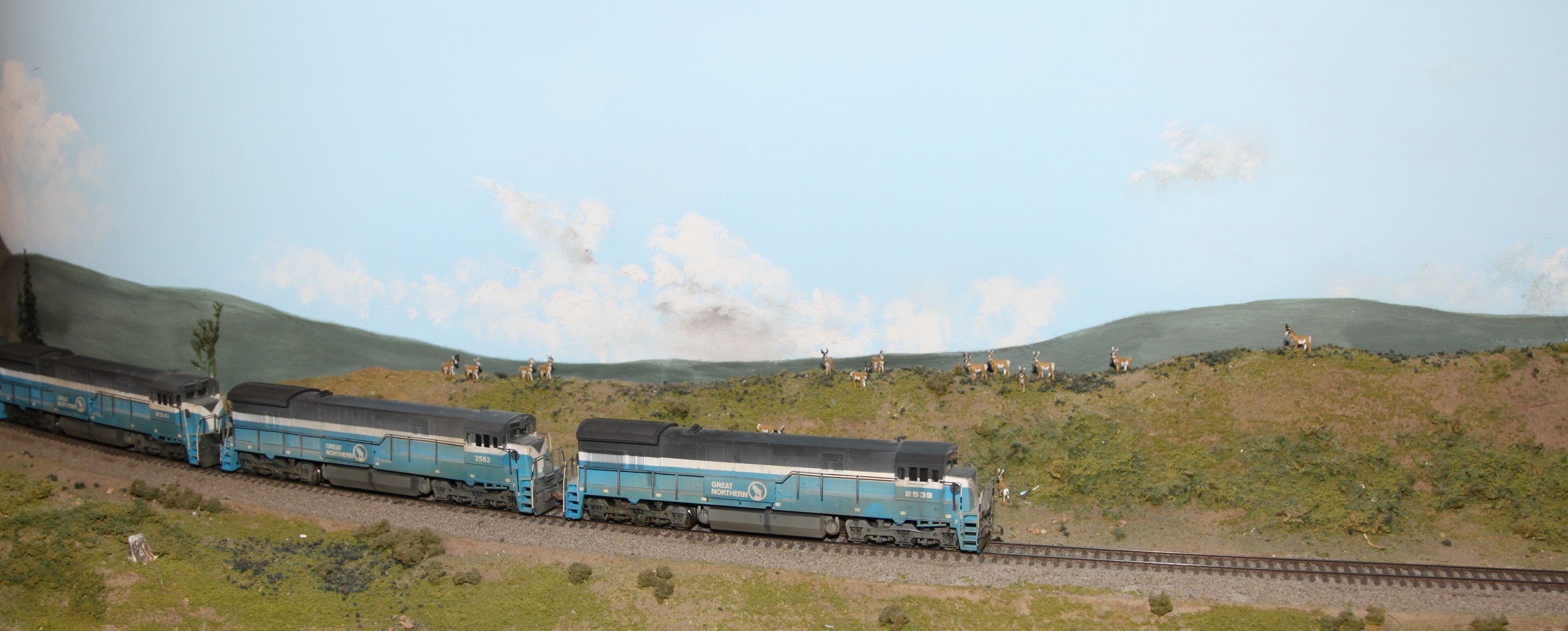
And then the real surprise. At the summit in Quartz Mountian there was not one train waiting but two. Extra #504 pulled by an old 4-8-4 Northern class steam locomotive, and The Portland Interchange #262 with the OC&E's youngest engineer (Josh) at the throttle. The interesting thing was that those two trains did not fit on the siding. Once again normally this is not a problem because as soon as I got tucked into the main, the #504 would proceed on behind me from whence we just came. Then #262 would pull all the way into the siding, allowing us to proceed to from whence it came. The golem in the gears was that unknown to us, train #141 the westbound Railblazer had been released to follow us up the hill. Instruction from Dispatch was that the Blazer was to pull into the siding directly behind us. The math said the two trains would fit, my eyeballs said it wouldn't. I kicked the throttle up as low is would go and still move the train, and inched it up right within a hair of tripping the next block signal. Still not going to fit. Then I realized that since #262 was already sitting in the block it was already tripped. I inched forward about 50 feet and then backed the train up back into my block where I was supposed to be. What this did was put all the slack into the train. Slack is the distance the couplers in the cars move depending on whether they are being pushed or pulled. When standing next to a train and one hears a low rumble or crashing sound move through the train, that is the slack being pulled out or put into the couplers as each car slams into the next. Since the ore train is 80 cars long and one considers 6" of slack in each plus caboose and locos taking the slack out shortened the train by about fifty feet.
As my eyeballs had told me, the locos of 141 crept in behind our caboose and was able to clear their caboose onto the track with only 10 feet of open track to spare. Putting the slack into the ore train saved the day. Note to self. Always report length to the dispatcher with all the slack taken out and the train stretched out to max size.
So thanks to slack, 4 trains were able to pass in Quartz Mountain.
Layout plan here:
http://www.gfsm.org/assets/images/OCEDiagram_Medium.jpg
There was heavy traffic on the road and my tour #251, the venerable ore train, pulled onto the main line in Fairport one block behind Extra 501. The extra soon pulled ahead and there was nothing but green lights going out of Lakeview. Through Dog Lake the whole crew got a treat of a good view of the lake creature which was out in full view right behind the boat house. The train had throttled up to 22 mph as it went up the valley past the hot box detector. Slid right through tunnel #4 and the town of Sycan slick as can be.
Things got interesting when we saw a flashing yellow signal approaching Bly. That isn't so surprising as normally this would mean there is a train waiting for us to pass. However, as we got to Bly the next signal was not the normal yellow, nor was there a train waiting. Instead the signal was flashing red. This means we are pulling into the siding behind a train already there. Bly is a big loop that doubles the railroad back on itself, so one can see the trains further up grade. So we have this flashing red but there are no trains anywhere in sight. That can only mean one thing. A really long wait.
We stopped at the flashing red and then proceeded at less than 5 mph into the siding watching for the caboose of what we assumed would be Extra 501 immediately ahead. Bly is a very long siding so it was no problem fitting the 80 cars of ore in behind 501. And sure enough the wait began. After about an hour, the facing train arrived. But in a way, it was worth it, as the facing train was a re-routed California Zephyr pulled by 4 rare D&RGW F units. That train is a long way from home rails.

Unfortunately after the Zephyr passed #501 did not leave. Looking across the valley again the reason was clear there was a train running one block behind the Zephyrs glowing drum head. It was not too long a wait before we saw it was the regional train #282, which rolled right on by us.
Finally the caboose of #501 pulled away from our nose as it took the main and we got to move up to the signal at the west end of Bly. We thought we would get to run the yellows and follow 501 up the hill, but it was not to be. It was another fairly long wait before train #232 lumbered by. Finally getting a green, the locos groaned to get the 80 loads of ore moving up hill once again. A herd of antelope looked on to see what all the locomotive grumbling was about as we rounded the turn toward tunnel #6.

And then the real surprise. At the summit in Quartz Mountian there was not one train waiting but two. Extra #504 pulled by an old 4-8-4 Northern class steam locomotive, and The Portland Interchange #262 with the OC&E's youngest engineer (Josh) at the throttle. The interesting thing was that those two trains did not fit on the siding. Once again normally this is not a problem because as soon as I got tucked into the main, the #504 would proceed on behind me from whence we just came. Then #262 would pull all the way into the siding, allowing us to proceed to from whence it came. The golem in the gears was that unknown to us, train #141 the westbound Railblazer had been released to follow us up the hill. Instruction from Dispatch was that the Blazer was to pull into the siding directly behind us. The math said the two trains would fit, my eyeballs said it wouldn't. I kicked the throttle up as low is would go and still move the train, and inched it up right within a hair of tripping the next block signal. Still not going to fit. Then I realized that since #262 was already sitting in the block it was already tripped. I inched forward about 50 feet and then backed the train up back into my block where I was supposed to be. What this did was put all the slack into the train. Slack is the distance the couplers in the cars move depending on whether they are being pushed or pulled. When standing next to a train and one hears a low rumble or crashing sound move through the train, that is the slack being pulled out or put into the couplers as each car slams into the next. Since the ore train is 80 cars long and one considers 6" of slack in each plus caboose and locos taking the slack out shortened the train by about fifty feet.
As my eyeballs had told me, the locos of 141 crept in behind our caboose and was able to clear their caboose onto the track with only 10 feet of open track to spare. Putting the slack into the ore train saved the day. Note to self. Always report length to the dispatcher with all the slack taken out and the train stretched out to max size.
So thanks to slack, 4 trains were able to pass in Quartz Mountain.
Layout plan here:
http://www.gfsm.org/assets/images/OCEDiagram_Medium.jpg
Last edited by a moderator:

